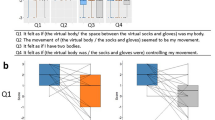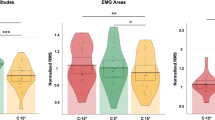Abstract
The mental representation of one’s body typically implies the continuity of its parts. Here, we used immersive virtual reality to explore whether mere observation of visual discontinuity between the hand and limb of an avatar could influence a person’s sense of ownership of the virtual body (feeling of ownership, FO) and being the agent of its actions (vicarious agency, VA). In experiment 1, we tested whether placing different amounts of visual discontinuity between a virtual hand and limb differently modulate the perceived FO and VA. Participants passively observed from a first-person perspective four different versions of a virtual limb: (1) a full limb; a hand detached from the proximal part of the limb because of deletion of (2) the wrist; (3) the wrist and forearm; (4) and the wrist, forearm and elbow. After observing the static or moving virtual limb, participants reported their feeling of ownership (FO) and vicarious agency (VA) over the hand. We found that even a small visual discontinuity between the virtual hand and arm significantly decreased participants’ FO over the hand during observation of the static limb. Moreover, in the same condition, we found that passive observation of the avatar’s actions induced a decrease in both FO and VA. We replicated the same results in a second study (experiment 2) where we investigated the modulation of FO and VA by comparing the visual body discontinuity with a condition in which the virtual limb was partially occluded. Our data show that mere observation of limb discontinuity can change a person’s ownership and agency over a virtual body observed from a first-person perspective, even in the absence of any multisensory stimulation of the real body. These results shed new light on the role of body visual continuity in modulating self-awareness and agency in immersive virtual reality.





Similar content being viewed by others
References
Arzy S, Overney L, Landis T, Blanke O (2006) Neural mechanisms of embodiment: asomatognosia due to premotor cortex damage. Arch Neurol 63:1022–1025
Baier B, Karnath H-O (2008) Tight link between our sense of limb ownership and self-awareness of actions. Stroke 39:486–488. doi:10.1161/STROKEAHA.107.495606
Botvinick M, Cohen J (1998) Rubber hands “feel” touch that eyes see. Nature 391:756. doi:10.1038/35784
Cardinali L, Brozzoli C, Farnè A (2009) Peripersonal space and body schema: two labels for the same concept? Brain Topogr 21:252–260. doi:10.1007/s10548-009-0092-7
Costantini M, Haggard P (2007) The rubber hand illusion: sensitivity and reference frame for body ownership. Conscious Cogn 16:229–240. doi:10.1016/j.concog.2007.01.001
Ehrsson HH (2007) The experimental induction of out-of-body experiences. Science 317:1048. doi:10.1126/science.1142175
Ehrsson HH, Spence C, Passingham RE (2004) That’ s my hand ! Activity in premotor cortex reflects feeling of ownership of a limb. Science 305:875–877. doi:10.1126/science.1097011
Ehrsson HH, Holmes NP, Passingham RE (2005) Touching a rubber hand: feeling of body ownership is associated with activity in multisensory brain areas. J Neurosci 25:10564–10573. doi:10.1523/JNEUROSCI.0800-05.2005
Evans N, Blanke O (2013) Shared electrophysiology mechanisms of body ownership and motor imagery. Neuroimage 64:216–228. doi:10.1016/j.neuroimage.2012.09.027
Garbarini F, Pia L, Piedimonte A et al (2013) Embodiment of an alien hand interferes with intact-hand movements. Curr Biol 23:R57–R58. doi:10.1016/j.cub.2012.12.003
Garbarini F, Fornia L, Fossataro C et al (2014) Embodiment of others’ hands elicits arousal responses similar to one’s own hands. Curr Biol 24:R738–R739. doi:10.1016/j.cub.2014.07.023
Gillies M, Spanlang B (2010) Comparing and evaluating real time character engines for virtual environments. Presence Teleoperators Virtual Environ 19:95–117. doi:10.1162/pres.19.2.95
Guterstam A, Petkova VI, Ehrsson HH (2011) The illusion of owning a third arm. PLoS One 6:e17208. doi:10.1371/journal.pone.0017208
Ide M (2013) The effect of “anatomical plausibility” of hand angle on the rubber-hand illusion. Perception 42:103–111. doi:10.1068/p7322
Invernizzi P, Gandola M, Romano D, Zapparoli L, Bottini G, Paulesu E (2013) What is mine? Behavioral and anatomical dissociations between somatoparaphrenia and anosognosia for hemiplegia. Behav Neurol 26:139–150. doi:10.3233/BEN-2012-110226
Kalckert A, Ehrsson HH (2012) Moving a rubber hand that feels like your own: a dissociation of ownership and agency. Front Hum Neurosci 6:40. doi:10.3389/fnhum.2012.00040
Kalckert A, Ehrsson HH (2014) The moving rubber hand illusion revisited: comparing movements and visuotactile stimulation to induce illusory ownership. Conscious Cogn 26:117–132. doi:10.1016/j.concog.2014.02.003
Lenggenhager B, Tadi T, Metzinger T, Blanke O (2007) Video ergo sum: manipulating bodily self-consciousness. Science 317:1096–1099. doi:10.1126/science.1143439
Lewis JS, Kersten P, McCabe CS et al (2007) Body perception disturbance: a contribution to pain in complex regional pain syndrome (CRPS). Pain 133:111–119. doi:10.1016/j.pain.2007.03.013
Lloyd DM (2007) Spatial limits on referred touch to an alien limb may reflect boundaries of visuo-tactile peripersonal space surrounding the hand. Brain Cogn 64:104–109. doi:10.1016/j.bandc.2006.09.013
Maselli A, Slater M (2013) The building blocks of the full body ownership illusion. Front Hum Neurosci 7:83. doi:10.3389/fnhum.2013.00083
Maselli A, Slater M (2014) Sliding perspectives: dissociating ownership from self-location during full body illusions in virtual reality. Front Hum Neurosci 8:693. doi:10.3389/fnhum.2014.00693
Newport R, Gilpin HR (2011) Multisensory disintegration and the disappearing hand trick. Curr Biol 21:R804–R805. doi:10.1016/j.cub.2011.08.044
Newport R, Preston C (2010) Pulling the finger off disrupts agency, embodiment and peripersonal space. Perception 39:1296–1298. doi:10.1068/p6742
Pavani F, Spence C, Driver J (2000) Visual capture of touch: out-of-the-body experiences with rubber gloves. Psychol Sci 11:353–359. doi:10.1111/1467-9280.00270
Perez-Marcos D, Sanchez-Vives MV, Slater M (2012) Is my hand connected to my body? The impact of body continuity and arm alignment on the virtual hand illusion. Cogn Neurodyn 6:295–305. doi:10.1007/s11571-011-9178-5
Petkova VI, Ehrsson HH (2008) If I were you: perceptual illusion of body swapping. PLoS One 3:e3832. doi:10.1371/journal.pone.0003832
Petkova VI, Ehrsson HH (2009) When right feels left: referral of touch and ownership between the hands. PLoS One 4:e6933. doi:10.1371/journal.pone.0006933
Petkova VI, Khoshnevis M, Ehrsson HH (2011) The perspective matters! Multisensory integration in ego-centric reference frames determines full-body ownership. Front Psychol 2:35. doi:10.3389/fpsyg.2011.00035
Romano D, Bottini G, Maravita A (2013) Perceptual effects of the mirror box training in normal subjects. Restor Neurol Neurosci 31:373–386. doi:10.3233/RNN-120273
Romano D, Pfeiffer C, Maravita A, Blanke O (2014) Illusory self-identification with an avatar reduces arousal responses to painful stimuli. Behav Brain Res 261:275–281. doi:10.1016/j.bbr.2013.12.049
Sacheli LM, Candidi M, Pavone EF, Tidoni E, Aglioti SM (2012) And yet they act together: interpersonal perception modulates visuo-motor interference and mutual adjustments during a joint-grasping task. PLoS One 7:e50223. doi:10.1371/journal.pone.0050223
Sacheli LM, Tidoni E, Pavone EF, Aglioti SM, Candidi M (2013) Kinematics fingerprints of leader and follower role-taking during cooperative joint actions. Exp Brain Res 226:473–486. doi:10.1007/s00221-013-3459-7
Sanchez-Vives MV, Spanlang B, Frisoli A, Bergamasco M, Slater M (2010) Virtual hand illusion induced by visuomotor correlations. PLoS One 5:e10381. doi:10.1371/journal.pone.0010381
Scandola M, Tidoni E, Avesani R et al (2014) Rubber hand illusion induced by touching the face ipsilaterally to a deprived hand: evidence for plastic “somatotopic” remapping in tetraplegics. Front Hum Neurosci 8:404. doi:10.3389/fnhum.2014.00404
Schmalzl L, Kalckert A, Ragnö C, Ehrsson HH (2013) Neural correlates of the rubber hand illusion in amputees: a report of two cases. Neurocase 20:407–420. doi:10.1080/13554794.2013.791861
Slater M, Perez-Marcos D, Ehrsson HH, Sanchez-Vives MV (2008) Towards a digital body: the virtual arm illusion. Front Hum Neurosci 2:6. doi:10.3389/neuro.09.006.2008
Slater M, Perez-Marcos D, Ehrsson HH, Sanchez-Vives MV (2009) Inducing illusory ownership of a virtual body. Front Neurosci 3:214–220. doi:10.3389/neuro.01.029.2009
Slater M, Spanlang B, Sanchez-Vives MV, Blanke O (2010) First person experience of body transfer in virtual reality. PLoS One 5:e10564. doi:10.1371/journal.pone.0010564
Synofzik M, Vosgerau G, Newen A (2008a) I move, therefore I am: a new theoretical framework to investigate agency and ownership. Conscious Cogn 17:411–424. doi:10.1016/j.concog.2008.03.008
Synofzik M, Vosgerau G, Newen A (2008b) Beyond the comparator model: a multifactorial two-step account of agency. Conscious Cogn 17:219–239. doi:10.1016/j.concog.2007.03.010
Synofzik M, Vosgerau G, Voss M (2013) The experience of agency: an interplay between prediction and postdiction. Front Psychol 4:127. doi:10.3389/fpsyg.2013.00127
Tecchia F, Carrozzino M, Bacinelli S, Rossi F, Vercelli D, Marino G, Gasparello P, Bergamasco M (2010) A flexible framework for wide-spectrum VR development. Presence Teleoperators Virtual Environ 19:302–312. doi:10.1162/PRES_a_00002
Tidoni E, Grisoni L, Liuzza MT, Aglioti SM (2014) Rubber hand illusion highlights massive visual capture and sensorimotor face-hand remapping in a tetraplegic man. Restor Neurol Neurosci 32:611–622. doi:10.3233/RNN-130385
Touzalin-Chretien P, Ehrler S, Dufour A (2010) Dominance of vision over proprioception on motor programming: evidence from ERP. Cereb Cortex 20:2007–2016. doi:10.1093/cercor/bhp271
Tsakiris M (2009) My body in the brain: a neurocognitive model of body-ownership. Neuropsychologia 48:703–712. doi:10.1016/j.neuropsychologia.2009.09.034
Tsakiris M, Haggard P (2005) The rubber hand illusion revisited: visuotactile integration and self-attribution. J Exp Psychol Hum Percept Perform 31:80–91. doi:10.1037/0096-1523.31.1.80
Tsakiris M, Prabhu G, Haggard P (2006) Having a body versus moving your body : how agency structures body-ownership. Conscious Cogn 15:423–432. doi:10.1016/j.concog.2005.09.004
Vosgerau G, Synofzik M (2012) Weighting models and weighting factors. Conscious Cogn 21:55–58. doi:10.1016/j.concog.2011.09.016
Wegner DM, Sparrow B, Winerman L (2004) Vicarious agency: experiencing control over the movements of others. J Personal Soc Psychol 86:838–848. doi:10.1037/0022-3514.86.6.838
Acknowledgments
We thank three anonymous reviewers for their helpful comments on this manuscript.
This work received financial support from the EU Information and Communication Technologies Grant (VERE project, FP7-ICT-2009-5, Prot. Num. 257695), the Italian Ministry of Health (and RF-2010-2312912), the BIAL foundation (awarded to ET, n° 2014/150).
Author information
Authors and Affiliations
Corresponding authors
Additional information
G. Tieri and E. Tidoni have contributed equally to this work.
Electronic supplementary material
Below is the link to the electronic supplementary material.
Rights and permissions
About this article
Cite this article
Tieri, G., Tidoni, E., Pavone, E.F. et al. Mere observation of body discontinuity affects perceived ownership and vicarious agency over a virtual hand. Exp Brain Res 233, 1247–1259 (2015). https://doi.org/10.1007/s00221-015-4202-3
Received:
Accepted:
Published:
Issue Date:
DOI: https://doi.org/10.1007/s00221-015-4202-3




